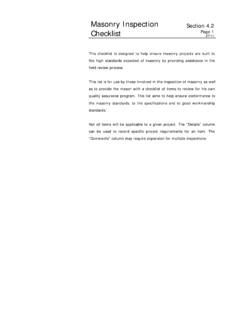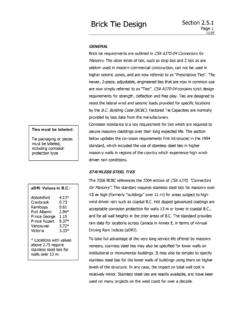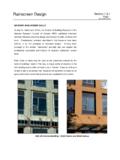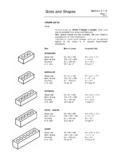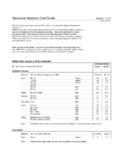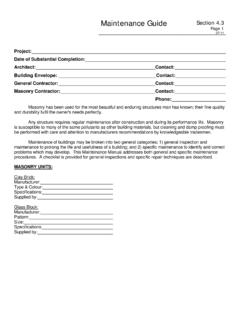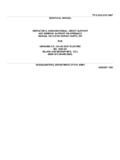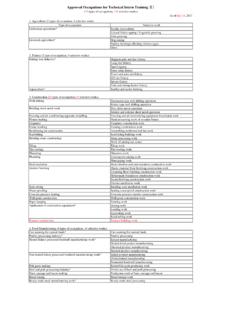Transcription of Wall Selection Guide Section 1 - masonrybc.org
1 Wall Selection Guide Section Page 1 07/11 MASONRY WALL TYPES Masonry is the most enduring of all building materials, as exemplified by the oldest and most revered architecture from around the world. The exceptional structural integrity and durability of traditional masonry walls are derived from the inherent properties of the materials, and from the robustness and built-in redundancies of these assemblies. Modern masonry walls have evolved to apply these historical benefits to meet the challenges of today's building designs. Masonry walls provide high-performance enclosures, which fulfill support, control and finish functions. Masonry loadbearing, infill and partition walls are physical barriers that provide privacy, security, and fire and sound separation. When they are part of the building envelope, masonry walls also act as a durable support for barrier and cladding elements, and of course may be utilized to provide the cladding as well.
2 Selecting a particular masonry wall assembly from the many available for a particular project can be influenced by many factors. This "wall Selection Guide ", along with other sections of this manual, is intended to outline technical and performance-related masonry design considerations to assist designers and prospective building owners with their decision making. For the purposes of this publication, masonry walls are divided into two types of assemblies. These are single wythe structural walls and multi-layered rainscreen veneer walls . Historic masonry walls are examples of structural walls where the characteristics of the assembly result primarily from the massive nature of the construction. The modern version of these walls employs reinforced, single wythe concrete block or structural clay units to provide the structure and much of the environmental separation.
3 See Section for further detailed information. Definitions: - Wythe: A continuous vertical Section of a masonry wall, one unit in thickness. - Single wythe wall: A wall composed of a single unit of masonry in thickness (a one brick or block thick wall). - Structural backing: the masonry or other system of structural members to which masonry veneer is tied. It is designed to withstand lateral loads ( wind and earthquake loads). - Veneer: A non-loadbearing masonry facing attached to and supported by the structural backing. - Rainscreen wall: an exterior wall assembly that contains a drainage cavity between the structural backing and the cladding. - Cavity wall: A construction of masonry units laid up with a cavity between the wythes. The wythes are tied together with metal ties or bonding units and are relied on to act together in resisting lateral loads. Section Page 2 07/11 Wall Selection Guide In this publication, the rainscreen veneer walls category includes wall systems that use an exterior masonry wythe as a cladding, where an air space separates the cladding from an airtight and insulated inner wall, regardless of whether masonry materials are used in the structural back-up wall.
4 Masonry cladding options include brick, block and stone veneers, supported by back ups such as concrete block, cast-in-place concrete or stud-frame systems. While rainscreen veneer walls are thin and light compared to most structural walls , the reputation for fitness-to-purpose associated with brick and stone-clad walls today derives in part from the robustness of masonry, even in single wythe veneer applications. See Section for further detailed information STRUCTURAL walls Structural walls were historically composed of several wythes, or layers of stone, clay or concrete masonry units. Multi-wythe clay brick or terra cotta walls constructed in the early part of this century are examples of this type of construction. Single wythe concrete block walls , reinforced for seismic and wind loads, are contemporary examples of structural walls . Single wythe masonry walls rely significantly on the capacity of masonry to perform building envelope barrier functions to resist environmental influences, such as wetting, drying, freezing and thermal expansion.
5 The choice of appropriate materials for units and mortar, careful workmanship to achieve full and dense mortar joints, and the application of surface water repellants or paints are important factors in the satisfactory performance of these walls . Block or brick structural walls provide an efficient combination of structural durability, good building envelope serviceability, attractive appearance, fire and sound resistance, and low construction and maintenance costs. (See Section for further detailed information) What is a loadbearing wall? - These walls resist dead and live vertical loads. Wall Selection Guide Section Page 3 07/11 RAINSCREEN VENEER walls In some applications and exposure conditions, the need for better control over rain penetration led to the incorporation of an air space or cavity in traditional walls to form a capillary break between two wythes of brick.
6 This type of two-stage wall can be referred to as a rainscreen wall when the air space behind the outermost element is drained and ventilated to the exterior and an effective air barrier is included on the back up assembly. These walls generally rely on the properties of a series of specific materials or components, such as thermal insulation to slow heat transfer, and air and vapour barriers to control movement of interior air, wind and water vapour. In masonry walls , this scientific approach to enclosure design has replaced the reliance on the inherent robustness and massiveness of masonry, resulting in lighter and more complex walls . In these walls , masonry is often used only as a veneer separated from the inner wall elements by an air space. The inner wall becomes a convenient location for structural components, fenestration and thermal insulation, as well as air and vapour tight assemblies and interior finishes.
7 Unlike new versions of the rainscreen approach with other materials, masonry rainscreen veneer wall design and construction has a successful track record for over half a century, and can be relied upon to provide high levels of performance and durability, even where moisture sensitive back-up materials are used. The highest available performance level is achieved where the back-up wall assemblies are also constructed of masonry. The multiple layers of materials and components of these walls act in concert to obtain a successful building enclosure. Where outward air leakage is important to occupancy conditions or where the building will be exposed to severe weather, the designer should consider the advantages of masonry rainscreen veneer walls . (See Section for further detailed information) Structural Design Section 107/11 The majority of residential buildings in the world are built of masonry - although often to a low level of construction quality.
8 For this reason, photo coverage of earthquake damage from distant villages frequently features piles of bricks or stones that were once homes. While these structures bear little resemblance to our modern reinforced masonry systems, they do illustrate the need for proper structural design. The seismic experience with masonry in California has shown that modern engineered masonry has generally provided a high level of performance. While this is reassuring for our local region, their experience with old unreinforced masonry structures highlights the need for close attention to our own stock of similar buildings. LIMIT STATES DESIGN Modern masonry design is similar to limit states design methods for other materials, particularly concrete. CSA S304-04 Design of Masonry Structures is referenced by the 2005 National Building Code and the 2006 Building Code.
9 The following three factors in CSA differentiate masonry design from reinforced concrete design: f'm f'm is the masonry compressive design strength. It is less than the masonry unit strength due to the effects of mortar bedding and interaction of the mortar and masonry unit. f'm is usually determined from the unit strength, as shown below in Table For some projects, such as those utilizing large amounts of high strength units, the alternative method of testing masonry assemblies (prisms) is occasionally used. m The m resistance (safety) factor for masonry was increased from to in the 2004 edition. Em Section Page 2 07/11 Structural Design The elastic modulus for masonry may be taken as Em=850 f'm (not greater than 20,000 MPa), or may be determined from testing. CSA also provides methods for determining effective moments of inertia for deflection calculations Value of f'm for concrete block masonry Specified compressive strength normal to the bed joint, f'm, for concrete block masonry, MPa Specified compressive strength of unit, MPa (average net area)
10 * Type S mortar Hollow Solid or grouted >40 22 17 30 20 13 10 15 10 5 *Linear interpolation is permitted. Notes: - For grouted walls the area of grout may be ignored and the Hollow f'm value used with the face-shell bedded area. This will be advantageous for larger spacings of grouted cells. - Alternatively, for partially grouted walls a weighted value between the Hollow and the Solid or Grouted may be used, based on the percentage of grouted cores.

